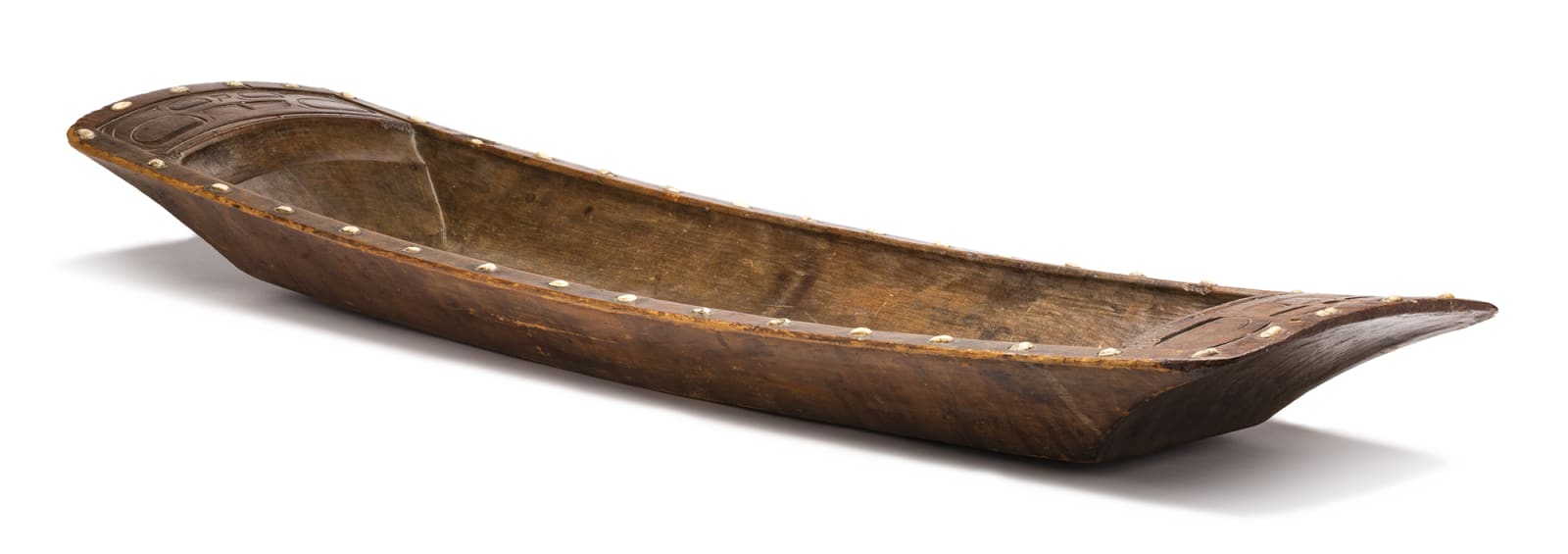-
Artworks
UNIDENTIFIED TLINGIT ARTIST
Feast Dish, early 1800scarved alder and opercula, 3.5 x 43.25 x 11.75 in (8.9 x 109.9 x 29.8 cm)
inscribed in an unknown hand in black ink [?]. "143[?] / 34".
LOT 49
ESTIMATE: $50,000 — $80,000
PRICE REALIZED: $48,000.00Further images
With its gentle curves and elegant proportions, this long feast tray or dish clearly made a grand entrance to a feast or ceremony. Large red turban snail opercula evenly spaced...With its gentle curves and elegant proportions, this long feast tray or dish clearly made a grand entrance to a feast or ceremony. Large red turban snail opercula evenly spaced about the rim add fine detail to this large object. Made to most likely hold smoked and dried fish or meats, it could contain a large capacity, probably requiring two sets of hands to carry. The narrow, flat bottom and flaring rise to the rim give it a vessel-like appearance, almost like a river canoe. While some Northwest Coast food dishes are literally canoe-shaped bowls, the affinity of all types to that form can be seen as an homage to the central role of canoes in the culture, without which large-scale food gathering and transportation would nearly be impossible.
Long narrow food trays of this type follow a traditional form with thin, overhanging ends, a wide, slightly undercut rim, and relief-carved flat designs on the end panels. The panels on this dish are shorter than many, perhaps a characteristic of its early origin. The abstract formline faces on each end panel are closely related in form but different in detail, and not clearly identifiable. A rich, dark patina has developed over the whole surface, indicating many generations of handling and use. The color is all the more striking when one considers that dishes of this kind are carved of alder, a naturally pale wood.
Steven C. Brown
References: For a fine comparable and contemporaneous Haida or Tsimshian example (without opercula) see Gilbert T. Vincent et al, Art of the North American Indians: The Thaw Collection, (Cooperstown: Fenimore Art Museum, 2000), pp. 336-337. For another elegant and slightly later Haida example (also without opercula) see Steven Brown, ed., The Spirit Within: Northwest Coast Native Art from the John H. Hauberg Collection, (New York: Rizzoli / Seattle: Seattle Art Museum, 1995), cat. 43; the aforementioned example is also illustrated and discussed in Bill Holm, The Box of Daylight: Northwest Coast Indian Art, (Seattle: Seattle Art Museum and Univ. of Washington Press, 1983), cat. 120. See also Renwick Gallery of the Smithsonian American Art Museum, Boxes and Bowls; Decorated Containers by Nineteenth-Century Haida, Tlingit, Bella Bella, and Tsimshian Indian Artists, (Washington: Smithsonian Institution Press, 1974), cats. 29-32. For a rather less elegant example see Henry B. Collins et al, The Far North: 2000 Years of American Eskimo and Indian Art, (Bloomington: Indiana University Press, 1977), cat. 223. See also Donald Ellis Gallery 2001 (Toronto: Donald Ellis Gallery, 2001), p. 29.
Provenance
Private Collection, British Columbia.
Join our mailing list
* denotes required fields
We will process the personal data you have supplied in accordance with our privacy policy (available on request). You can unsubscribe or change your preferences at any time by clicking the link in our emails.












